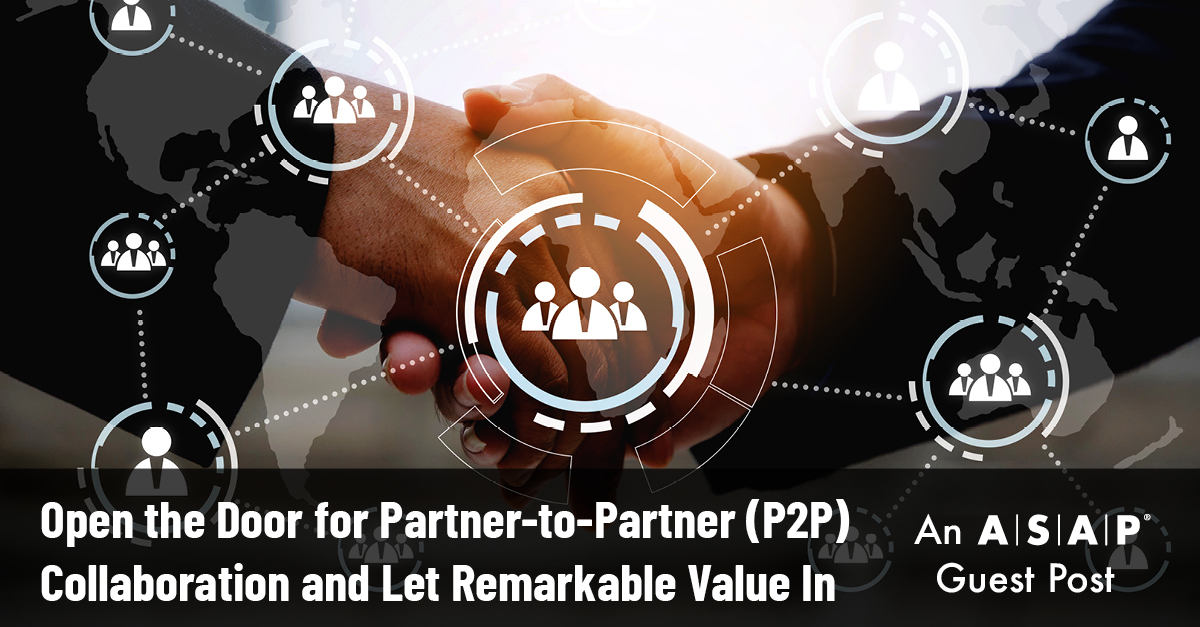Guest Blog Post: Open the Door to Partner-to-Partner Collaboration and Let Remarkable Value In
As partnership professionals we are often deeply focused on two areas. First, of course, is developing and maintaining successful alliances. Second is making sure everyone in our internal organization is aware of the partnerships we have created—and is helping to maximize the opportunities available from them.
But there is a third strategic area that can produce benefits and is sometimes overlooked: partner-to-partner (P2P) collaboration. For this discussion, we’ll distinguish direct partnerships from partner-to-partner (P2P) relationships.
Direct Partnerships
Let’s consider direct partnerships as those where there is a straightforward relationship between two businesses. They collaborate in the market to bring value to common customers, or they refer business to each other. They may even codevelop products.
If the companies are technology partners, they will likely offer adjacent and complementary solutions. There may be prebuilt APIs to transfer data, standard single sign-on capabilities, and shared client support—all designed to give the mutual customer a great experience. With service provider partners, there can be a range of offerings including implementation, product optimization, and consulting.
P2P Relationships
On the other hand, when companies that are not direct partners share ideas about strategy and tactical approaches, this is a P2P relationship.
Simply put, P2P is the connection between companies that are not direct partners. Putting some energy into developing and expanding P2P relationships can produce remarkable value and be eye-opening for partner professionals.
P2P organizations might be members of a common partnership community or partner ecosystem. That is, they both might be partners with a third company. For example, in the technology area, consider a software company that has a partner program. It is a hub-and-spoke model. The main software company is the hub and will typically have technology partners and service providers, including system integrators (SIs), as spokes in its alliance program.
When two or more of the spokes connect with each other that is P2P. They may both be integrated with the hub software provider for different products or services. The partners might both be in the Microsoft Partner Network, for instance.
How P2P Can Be Valuable
When two or more technology or service partners communicate and share ideas it can be fantastic. They quickly realize they have so much in common. Both might be facing some of the same challenges, successes, opportunities, and goals. One partner may have discovered important information or an approach that can be shared with the other partner to drive greater success. That is partner-to-partner collaboration. It is why investing time and resources in P2P can make a positive difference for partner professionals.
Sometimes partners are reluctant to communicate with one another. Maybe they feel their processes are too proprietary and must not be revealed to others. Or maybe they just don’t think it is a good use of time and the effort is too onerous. However, based on discussions with a healthy number of partnership and alliance managers, those concerns are usually unwarranted. In fact, in my experience, I see compelling proof that P2P collaboration can produce remarkable value.
Having developed P2P relationships myself, I have seen the benefits firsthand. These include an introduction to a key contact, a suggestion on how to position a partnership for success, a product enhancement, an adjacent possibility, a new technology to consider. As with other relationships, sharing ideas, best practices, and different approaches can be enlightening.
Encouraging P2P: More for Everyone
Some major partnership managers with meaningful alliance programs are starting to urge more P2P collaboration among their ecosystem members. They have seen how this can build strength and are supporting the practice. And there is a compounding effect: when one partner has developed a winning method, they can share it with another partner and it generates more for everyone.
Getting Started: Open the Door
As partner managers, we should invest time in P2P collaboration and try to develop a P2P mindset. How do you start? Here’s a suggested framework:
- Set a goal of creating one P2P relationship each quarter.
- Reach out to another alliance manager, introduce yourself, and ask if there is interest in having a discussion to share ideas and get to know each other.
- Make contact and then schedule a recurring check-in call once a quarter to catch up.
Over time, it may be worth expanding the P2P collaboration beyond the partnership managers, too. For example, each partner does an enablement session for the other company’s sales or client success colleagues. These teams then become smarter about each other's offerings and services, which can be mutually beneficial to customers and prospects. In the future, these relationships can be leveraged in a number of ways.
Professional Fulfillment
Still another benefit of P2P is for the partnering professionals themselves. We all get fixed in our thoughts and beliefs to some extent. By talking to colleagues at other companies, we broaden our horizon and learn about new ways of doing things.
We hear what has worked at another company. And we get a chance to share successes and frustrations and to network with others in similar roles. Often the information gained in these conversations can have a huge impact.
Another Way to Add Value
P2P is another way for partnership professionals to add value and develop fresh ideas. What’s more, P2P can improve results for our employers and customers. As with any vision, P2P collaboration requires some creativity and effort to turn the goals into action.
Experience has shown that developing and cultivating these new relationships (even when you have a full plate of other items) can add to the success of partnership programs and partnership professionals.
Ezra Schneier is corporate development officer with HRSoft, a work technology software company. He can be reached at Ezra.Schneier@HRSoft.com.

